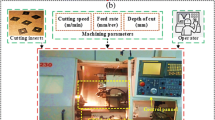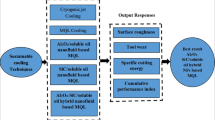Abstract
In manufacturing industry, the expenses for cutting fluids are about 7 to 17% of total production cost. The cutting fluids increase the health hazards as well as can cause a lot of environmental problems. In order to eliminate the ill effects associated with cutting fluids, it is now becoming necessary to move towards more sustainable techniques. To improve the surface quality of product and to minimize the expenditure of energy and resources it is essential to do optimization of turning parameters under sustainable cooling technique. For that purpose, grey relational analysis (GRA) proves to be a superior optimization technique to forecast and decision-making in various areas of manufacturing sector. In this research work, minimum quantity lubrication (MQL) setup has been developed and utilized for the experimentation. The nanofluids were prepared by adding the silicon carbide (SiC) nanoparticles (NPs) to the soluble oil with different weight percentages (0.5 wt.%, 1 wt.%, 1.5 wt.%). The thermal and tribological properties of SiC nanofluids were analyzed. Comparative analysis of MQL and SiC nanofluids based MQL turning has been done. Experimental results revealed that, the turning performance under SiC based nanofluids MQL mode is better as compared to MQL. The experimentation was planned as per Taguchi methodology. GRA has been employed to optimize the process parameters during turning of EN-24 steel under SiC based nanofluids MQL environment for better machining performance characteristics. The turning parameters under SiC based nanofluids MQL environment were optimized by GRA to obtain improved surface quality. The results revealed that optimization through GRA enhance output quality characteristics.
Similar content being viewed by others
References
Singh H, Kumar P (2006) Optimizing feed force for turned parts through the Taguchi technique. Sadhana 31(6):671–681
Komanduri R (1982) Catastrophic shear instability in high speed machining of AISI 4340 steels. Trans ASME J Eng Ind 104:121–128
Astakhov VP (2008) Ecological machining: near-dry machining. Machining Springer, pp 195–223
Sivaiah P, Chakradhar D (2018) Analysis and modeling of cryogenic turning operation using response surface methodology. Silicon 10:1–8
Khan MMA, Mithu MAH, Dhar NR (2009) Effects of minimum quantity lubrication on turning AISI 9310 alloy steel using vegetable oil-based cutting fluid. J Mater Process Technol 209(15–16):5573–5583
Attanasio A, Gelfi M, Giardini C, Remino C (2006) Minimal quantity lubrication in turning: effect on tool wear. Wear 260(3):333–338
Dhar NR, Islam MW, Islam S, Mithu MAH (2006) The influence of minimum quantity of lubrication (MQL) on cutting temperature, chip and dimensional accuracy in turning AISI-1040 steel. J Mater Process Technol 171(1):93–99
Dhar NR, Ahmed MT, Islam S (2007) An experimental investigation on effect of minimum quantity lubrication in machining AISI 1040 steel. Int J Adv Manuf Technol 47(5):748–753
Hwang YK, Lee CM (2010) Surface roughness and cutting force prediction in MQL and wet turning process of AISI 1045 using design of experiments. J Mech Sci Technol 24(8):1669–1677
Hadad M, Sadeghi B (2013) Minimum quantity lubrication-MQL turning of AISI 4140 steel alloy. J Clean Prod 54:332–343
Zohoor M, Yousefi S (2018) Experimental investigation of the effect of processing parameters on the surface roughness operation for using as expert system database. J Braz Soc Mech Sci Eng 40(5):273
Amrita M, Srikant RR, Sitaramaraju AV, Prasad MMS, Krishna PV (2013) Experimental investigations on influence of mist cooling using nanofluids on machining parameters in turning AISI 1040 steel. Pro Inst Mech Eng J 227(12):1334–1346
Khandekar S, Sankar MR, Agnihotri V, Ramkumar J (2012) Nano-cutting fluid for enhancement of metal cutting performance. Mater Manuf Process 27(9):963–967
Ganesan K, Babu MN, Santhanakumar M, Muthukrishnan N (2018) Experimental investigation of copper nanofluids based minimum quantity lubrication in turning of H 11 steel. J Braz Soc Mech Sci Eng 40(3):160
Sarıkaya M, Güllü A (2015) Multi-response optimization of minimum quantity lubrication parameters using Taguchi-based grey relational analysis in turning of difficult-to-cut alloy Haynes 25. J Clean Prod 91:347–357
Tosun N, Pihtili H (2010) Grey relational analysis of performance characteristics in MQL milling of 7075 Al alloy. Int J Adv Manuf Technol 46(5–8):509–515
Mia M, Al Bashir M, Khan MA, Dhar NR (2017) Optimization of MQL flow rate for minimum cutting force and surface roughness in end milling of hardened steel (HRC 40). Int J Adv Manuf Technol 89(1–4):675–690
Malik A, Manna A (2018) Multi-response optimization of laser-assisted jet electrochemical machining parameters based on Grey relational analysis. J Braz Soc Mech Sci Eng 40(3):148
Julong D (1989) Introduction to grey system theory. J Grey Syst 1(1):1–24
Singh S, Singh I, Dvived A (2013) Multi objective optimization in drilling of Al6063/10% SiC metal matrix composite based on grey relational analysis. Proc Inst Mech Eng B J Eng Manuf 227(12):1767–1776
Sallehuddin R, Shamsuddin SMH, Hashim SZM, Roselina M (2008) Grey relational analysis and its application on multivariate time series. In Proceedings of IEEE International Conference on intelligent Systems Design and Applications (Vol. 2)
Sindhu D, Thakur L, Chandna P (2018) Multi-objective optimization of rotary ultrasonic machining parameters for quartz glass using Taguchi-Grey relational analysis (GRA). Silicon:1–2
Sharma P, Chakradhar D, Narendranath S (2018) Analysis and optimization of WEDM performance characteristics of Inconel 706 for aerospace application. Silicon 10(3):921–930
Patel KM, Pandey PM, Rao PV (2010) Optimisation of process parameters for multi-performance characteristics in EDM of Al2O3 ceramic composite. Int J Adv Manuf Technol 47(9–12):1137–1147
Das SK, Putra N, Thiesen P, Roetzel W (2003) Temperature dependence of thermal conductivity enhancement for nanofluids. J Thermophys Heat Transf 125(4):567–574
Ranjbarzadeh R, Moradikazerouni A, Bakhtiari R, Asadi A, Afrand M (2019) An experimental study on stability and thermal conductivity of water/silica nanofluids: eco-friendly production of NPs. J Clean Prod 206:1089–1100
Murshed SS (2011) Determination of effective specific heat of nanofluids. J Exp Nanosci 6(5):539–546
Sharma VS, Singh G, Sorby K (2015) A review on minimum quantity lubrication for machining processes. Mater Manuf Process 30(8):935–953
Kalpakjain S, Schmid SR, Sekar KSV (2014) Manufacturing engineering and technology. Agenda
Klocke F, Lung D, Arft M, Priarone PC, Settineri L (2013) On high-speed turning of a third-generation gamma titanium aluminide. Int J Adv Manuf Technol 65(1–4):155–163
Author information
Authors and Affiliations
Corresponding author
Additional information
Publisher’s Note
Springer Nature remains neutral with regard to jurisdictional claims in published maps and institutional affiliations.
Rights and permissions
About this article
Cite this article
Thakur, A., Manna, A. & Samir, S. Multi-Response Optimization of Turning Parameters during Machining of EN-24 Steel with SiC Nanofluids Based Minimum Quantity Lubrication. Silicon 12, 71–85 (2020). https://doi.org/10.1007/s12633-019-00102-y
Received:
Accepted:
Published:
Issue Date:
DOI: https://doi.org/10.1007/s12633-019-00102-y




